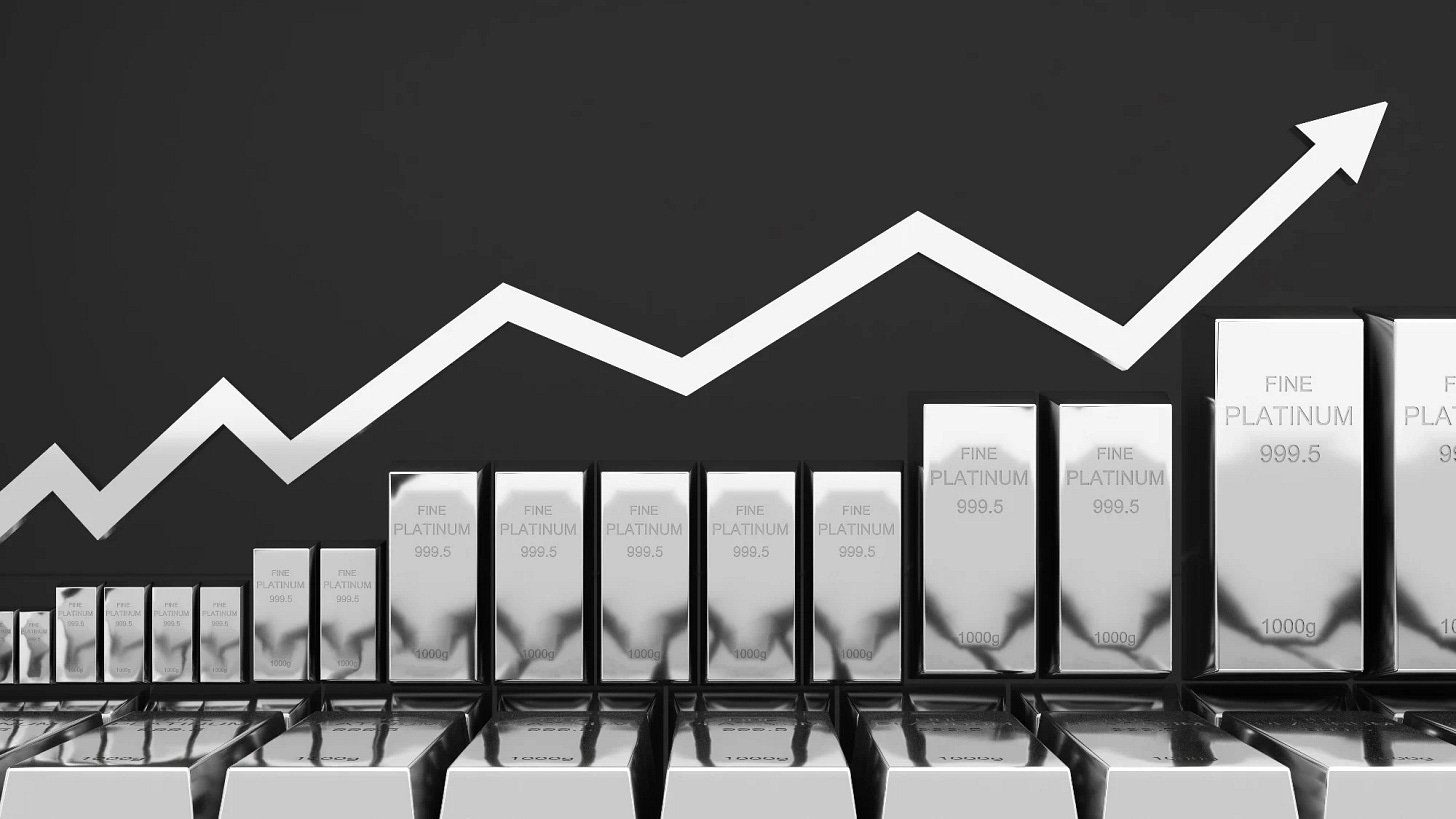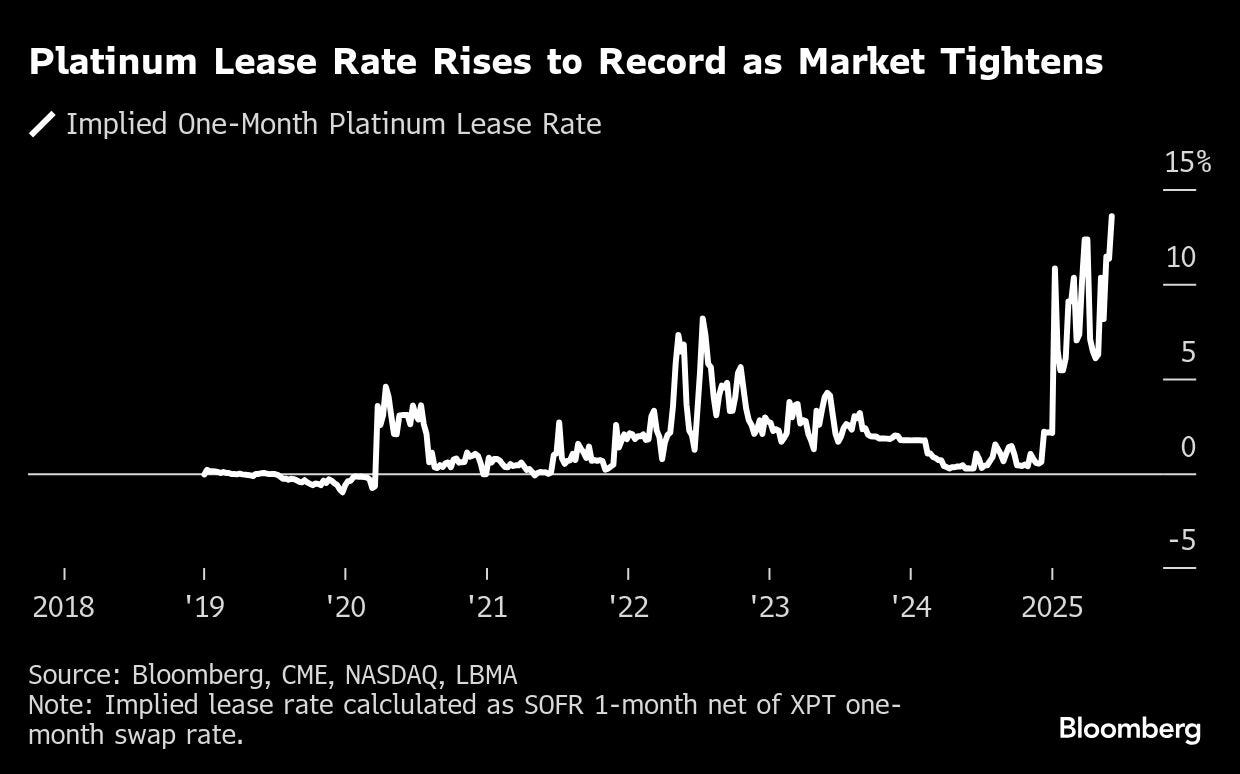Platinum's Price Surge vs Demand is a Complex Tale
Economic strain in China adds to U.S. fiscal concerns, sanctions and much more.
In a conversation with veteran MarketWatch journalist Myra P. Saefong, I discussed the problems with and the factors leading to platinum’s massive surge this past May. Portions of my commentary can be found in Myra’s article here on MarketWatch, here on Morningstar, and here on Metals Mine. Here is the full reasoning that informed my commentary. Read on!
Around half of the world’s platinum supply is consumed in the manufacturing of catalytic converters. Globally, the demand for pure EVs (“Electric Vehicles”) is in decline while demand for hybrids is rising and that for ICE (“Internal Combustion Engine”)-powered vehicles has remained resilient. Both hybrids and ICE vehicles have exhaust pipes with catalytic converters.
Commodity trajectory trends also bear out this trend: over the past year, Lithium Carbonate prices have declined by 38% while platinum prices have risen 30%.

State of Supply/Demand
Considering that nearly half of all platinum used is consumed by the automobile industry, it’s important to note that platinum demand isn’t determined solely by the number of automobiles produced but also by the number of miles/kilometres driven: catalytic converters generally need to be replaced every 100,000 miles/160,000 kilometres. If there were progressively fewer vehicles on the road all over the world, there is a case to be made that platinum would structurally dip in value. However, this isn’t the case.
South Africa traditionally produces about three-fourths of the world’s platinum while Russia produces a tenth. Sibanye Stillwater’s Kroondal mine in South Africa — accounting for about 4% of global production — is slated to operate until 2027. Combined with the sanctions on Russia, there is going to be progressively increasing squeeze on global supply.
Now, platinum’s “sister metal” palladium can be substituted on an almost 1:1 basis in autocatalysis processes. Historically, palladium is largely preferred for diesel-fueled vehicles — since their engines typically run at lower temperatures — while platinum is generally preferred for petrol/gasoline-fueled engines. Now, diesel engines are more prevalent in commercial vehicles than passenger vehicles. The sales trends for commercial vehicles are relatively less volatile when compared to passenger vehicles. One factor explaining the resurgence in platinum price, thus, underlines the notion that electrified passenger vehicles will continue to lose favour.
Russia accounts for around half of all palladium mined in the world. Sanctions arising from the Russo-Ukrainian conflict has led to palladium supplies drying up and manufacturers switching to platinum in catalytic converters instead — thus forming the second factor behind platinum’s increase.
Outside of sanction-related issues, however, there is a developing price incentive for a for substituting platinum with palladium: after holding a premium over platinum from 2019 through 2023, platinum is currently over 25% cheaper than platinum.

However, most of this discounting is on the back of increased recycling as opposed to identifying primary extraction sources (i.e. mining). The lack of substantial diversification out of Russian sources likely weighs heavy on substituting into palladium currently. Once sanctions are lifted and commerce normalizes, a cooling of platinum prices can be expected as substitution in favour of palladium increases. However, this is a slow-moving process requiring around 4-5 years to be seen in substantial volumes.
Catalytic converters have been enforced in vehicles for about half a century now, which means that there is substantial potential to replenish stocks from recycling — which yields quite a high collection rate in platinum’s case. However, only about a fourth of global platinum supply is from recycling. A concerted effort to consolidate and normalize end-of-life recycling could double this contribution and stave off supply squeeze from extraction constraints. However, this hasn’t materialized yet. Given these factors, industry-driven demand continues to provide support for platinum’s long-term bullishness.
Trajectory Factors
Inflationary concerns have been dampening new automobile purchases and ballooning used car values. While overall car sales are trending to be somewhat weak, the share of hybrids and ICE-powered cars are likely to stay strong and even eat into pure EV sales growth trends. In dollar terms, the U.S. is the world’s largest car market and is scheduled to repeal EV subsidies via President Trump’s “Big Beautiful Bill”, which charging EVs an annual fee that is greater than that imposed on ICE-powered cars. Models by Princeton University posit that the loss of subsidies and the imposition of fees would altogether cut U.S. EV sales by 40% in 2030.
Meanwhile, the CEO of China’s Great Wall Motor Wei Jianjun — in an interview with Sina Finance on the 23rd of May — called out the practice of “zero-kilometre used cars”, wherein cars freshly produced by carmakers are registered and assigned licence plates (thereby marking them as “sold” in official statistics) without ever having been driven before being sold in the secondhand market. Mr. Wei said that at least 3,000 to 4,000 vendors on Chinese used car platforms were selling such cars. These sales statistics essentially prop up sales figures for a number of EV carmakers in China and distorts the overall market – leading to Chinese regulators almost immediately summoning top carmakers and automobile associations for a closed-door meeting.
While the U.S. action is very much still in play as it heads for the Senate, it potentially dampens EV sales growth by making EVs more expensive to buyers. On the other hand, actual Chinese sales figures — absent the “zero-kilometre used car” practice — might indicate that EV growth in China (the largest car market for EVs in volume) has bottomed out. All in all, hybrids and ICE-powered vehicles seem to have more longevity than previously assumed.
Platinum see-sawed through most of the Year Till Date (YTD) until May due to uncertainties over the forward outlook for new car sales. Earlier in the year, platinum prices rose in spurts as U.S. manufacturers stockpiled platinum over expectations of tariffs being imposed. However, lease rates in London and Zurich remain persistently high despite some volumes being moved out from storage.
In May, however, platinum received something of a second-order boost courtesy of the “Big Beautiful Bill”: the U.S. budget deficit is now expected to widen and bond issuances are expected to continually become less attractive which started to cause the U.S. dollar to dip. This dip further increased the flight of capital to “storehouse of value” metals such as gold and silver — which were already running very high (with gold going up nearly 50% over the past year).
Topped-out “storehouse” metal prices caused increased flows into platinum as an investment via physical purchases and ETFs, with Chinese investors leading the fray. Palladium, meanwhile, didn’t rise quite as rapidly since its supply is constrained due to sanctions on Russia and current trends favouring platinum’s utilization.
Note: Chinese investor actions in the face of the picture painted by China’s official data are highly suggestive of the notion that China’s citizenry are experiencing substantial economic strain. Commodity trends were analyzed in an article published here in July last year while my article on SeekingAlpha published near the end of 2023 postulated that China was facing headwinds 20 years in the making.
Platinum Prices Going Forward
Even without the speculative hype from investors seeking “storehouse of value” propositions from platinum like they do from gold and silver, the long-term outlook for platinum price is bullish as mining costs increase, demand for platinum remains steady and recycled platinum contributions remain low.
While the May rally was something of a surprise, the underlying factors can now be attributed to extenuating circumstances — namely the non-availability of Russian supplies of platinum as well as palladium, concerns over the ballooning deficit from the “Big Beautiful Bill” creating flight-of-capital conditions out of the bond markets, the declination of the U.S. dollar, and economic headwinds in China. Until May, the industry supply-demand cycle was fairly stable and largely correlated with the outlook of the global auto market. The speculative burst is certainly a cause for concern, which will work its way back to end users — mostly car buyers.
Outside of the automotive industry, the bulk of the remaining volume is used in the chemical industry for the production of nitric acid (mainly for fertilizers) and silicones (i.e. sealants, insulating material, et al). Around 15-25% of total supply is used in jewellery — although it isn’t quite as popular as gold and silver (of course). After these industries have run out their reserves (or get close to), there is no option but to buy into the cascade and further raise prices. Thus, the predominant casualties of high platinum prices would be the customers of carmakers and the fertilizer industry — namely car buyers and farmers (who will, in turn, pass this on to the kitchen table).
Platinum also has utility as a catalyst in the generation of hydrogen — making it extremely important for hydrogen fuel cell (HFC)-powered cars currently deployed in small volumes by the likes of Toyota and Hyundai and currently under development at BMW and Tata Motors, among others. High platinum prices could also force HFC-driven vehicle research to expend capital in finding a suitable replacement, thus delaying the large-scale deployment of Fuel Cell Electric Vehicles (FCEVs). A supply surplus, on the other hand, might actively accelerate the development of FCEVs.
Current price levels are facing resistance and prices likely wouldn’t go past $1,300. Over the next quarter, the $1,300 level will likely be met and tested. On the other hand, if capital is “triggered” into shifting to gold and silver — as it historically has — then platinum faces a significant declination of about 17-23% from its present value, i.e. to the $1,000 range, thus locking into the industry supply-demand cycle rather than speculative hype from “safe harbour” seekers.
After the “trigger”, platinum will be rationalized and bullish. Absent the “trigger”, platinum might continue to rise without rationalization. These two scenarios may sound similar, but they aren’t the same. Platinum is funny like that.
For a list of all articles ever published on Substack, click here.






